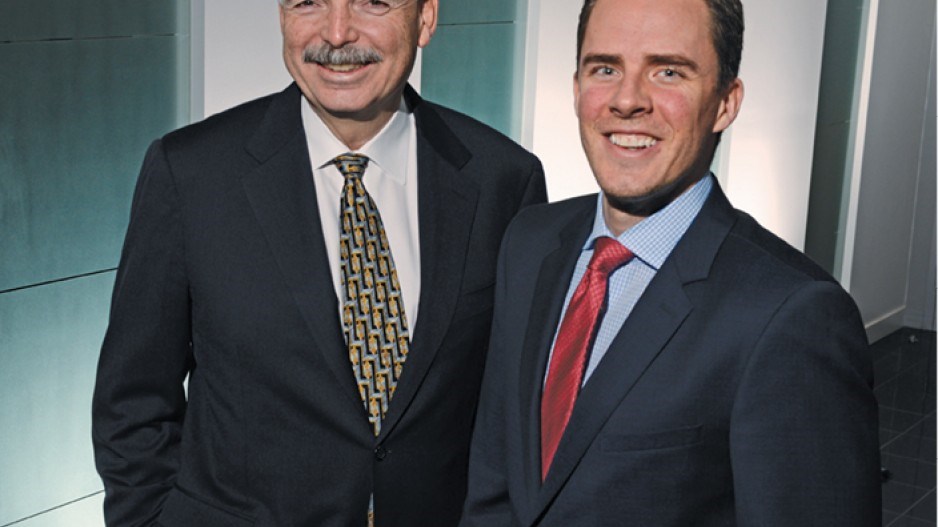When Onni Development Corp. paid $110.5 million for 12.5 acres of land in North Burnaby on December 30, 2013, it capped a year in which land transactions dominated Metro Vancouver's commercial real estate market.
Metro land sales in 2013 tallied more than $2.52 billion, accounting for half of all commercial sales and dwarfing the second-place retail sector. Land transactions are worth more than all industrial, office, multi-family and hotel property sales combined and have led all market sectors in the region for the past two years.
In 2013's fourth quarter, sales of land for medium- and high-density residential alone accounted for 32.3% of the market, with 99 transactions valued at $475 million.
In the Onni land deal, the property – a mix of older office buildings and vacant land – is earmarked for a high-density residential and commercial development nearly embracing the Gilmore SkyTrain station, according to Kevin Meikle, who acted as point agent on the transaction as vice-president and executive director of investment sales with Cushman & Wakefield Ltd.
At $9.5 million an acre, the Onni purchase differs in scale only to the infill land assemblies that now characterize a land-starved region. In a transaction that closed January 9 of this year, 8822999 (Marpole) Ltd., paid Gardenia Investments Ltd. $12.5 million for a 0.67-acre assembly in the 7500 block of Cambie Street in Vancouver, the equivalent of $24 million per acre.
One of the largest transactions in 2013, the $166 million sale of the Canada Post Corp. building in downtown Vancouver, is considered a commercial land sale, said Paul Richter, director of research at RealNet Canada Inc., because the 60-year-old post office will be demolished. The British Columbia Investment Management Corp. paid more than $55 million per acre for the 2.9-acre site in January 2013.
The startling prices underscore a key issue: with 134,000 acres locked in the agricultural land reserve (ALR) and another 40,000 acres under First Nations reserves, land for development in Metro Vancouver is precious and pricey.
Sites for industrial development are particularly scarce. A landmark 2013 study by NAIOP, which represents commercial and industrial developers, found that just 2,500 acres of land were "truly available" for immediate industrial development.
Graeme Silvera, president of the NAIOP Vancouver chapter, warns that land is being taken up quickly today due to demand for large warehouse distribution facilities.
"Based on anecdotal evidence supplied of a higher absorption rate of up to 400 acres per year [the current inventory] could represent about a six- or nine-year supply," Silvera said.
The shortage of industrial land is already affecting the market, according to Colliers International.
Sales of industrial property fell to just 35 units in 2013's fourth quarter, worth $106 million, down 43% from a year earlier.
"The industrial market has no shortage of eager buyers, but sellers are few," Colliers noted in a recent report.
With a looming shortage of land, industrial development might go the way of high-density residential, with older properties being assembled, bulldozed and rebuilt, Colliers suggested. •
First Nations land
Faced with the high costs and lack of large land parcels in Metro Vancouver, Toronto-based Ivanhoé Cambridge turned to First Nations to secure 175 acres to build the second-largest shopping centre in British Columbia.
Property Development Group's adjacent Tsawwassen Commons will provide another 550,000 square feet of outdoor retail space. This represents 40 acres of former farmland paved and roofed within a short drive of Vancouver, land likely impossible to find outside of a First Nations reserve.
Under the agreement with the Tsawwassen First Nations (TFN) – which acquired the former ALR land in a 2009 swap with the province – the developers have signed a 99-year lease, and the TFN will also benefit through employment initiatives.
Daniel Fournier, Ivanhoé chairman and CEO, said the deal represents a $600 million commitment, but it's not known how much of that is in the cost of leasing the land.
Farmland
Preservation of farmland has wide public support, but it's also the main reason Vancouver has the world's second-least affordable housing – and small infill sites sell for tens of millions of dollars – according to U.S.-based research firm Demographica.
Demographia principal Wendell Cox believes B.C.'s agricultural land reserve is largely responsible for Vancouver's high housing prices.
"The leadership of B.C. has placed the preservation of agricultural land at a higher priority than the standard of living of people and the minimization of poverty," Cox told Business in Vancouver.




